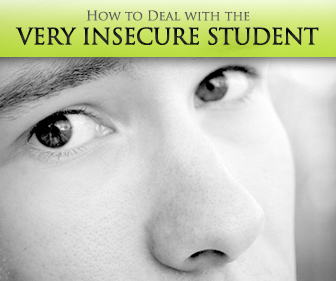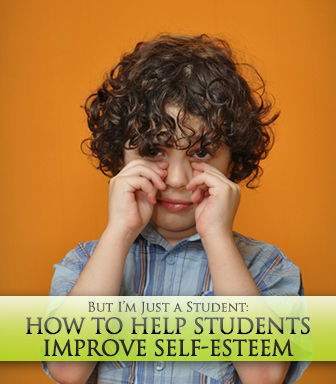So Sorry to Keep Bothering You: Dealing with the Very Insecure Student


Some of this is true in a culture that has been focused heavily, especially in the past several decades, on building its young people’s self-esteem, through sometimes dubious methods such as excessive praise for modest efforts and achievements. However, there are those students, particularly those of underprivileged backgrounds with little family support, for whom self-esteem is really an issue, evidenced by their timid manner, lack of eye contact, tendency to sit in the back of the room where they can’t see or hear, lack of interaction with other students, extreme unwillingness to ask for help, and so forth. Is there anything a teacher - rather than a psychologist or parent - can do for such students? And if so, what?

Problems in American culture in general and its students in particular tend to be diagnosed as “lack of confidence” or “poor self-esteem.” This is perhaps not surprising for a people for whom confidence is an important value: confidence in one’s achievements and person is highly valued in the U.S., rather than the modesty that tends to be more so in other cultures. However, not every problem a student has necessarily stems from lack of self-esteem. For example, my inability to serve at tennis well had more to do with having been improperly coached than not having confidence in the ability to play. Sometimes it really is a lack of skill, not lack of confidence. And sometimes lack of confidence is not at all a bad thing: if the student lacks the confidence in getting up and delivering a speech, it may actually be the case that the student is able to deliver the speech and really does just need some encouragement. However, it also may very well signal her lack of preparation for the task and the need to practice more, resulting in a reasonable lack of confidence. So before the teacher even begins to delve into the whole “confidence” issue, he should first determine if the student just needs further practice, better instruction, more explanation, and so forth, rather than a pep talk. And if it is actually a need for more instruction rather than esteem building, the student’s increased confidence is actually likely to be a natural outcome of mastery of the task after further preparation.
However, if the teacher does find that the student does know the material well but has developed a case of nerves, or the student is so lacking in confidence in general that it impairs his ability to learn, some steps can be taken to increase the student’s self-esteem and move toward content learning and mastery—the goal of instruction, after all (rather than confidence in and of itself).

Often students enter class with preconceived notions that they “just aren’t good at languages,” they “aren’t good in school,” or they “aren’t born writers,” and so forth. Probing and discussing these preconceptions with students individually or the class as a whole—as they are common preconceptions worth addressing—can help: most people over the age of seven or so have to work hard to learn another language; no one is a born writer as humans don’t just begin writing at certain age as they do walking or speaking, and writing is something everyone has to learn, etc., can help students ultimately banish some of these blocks to their self-esteem and see they are really in most cases in no worse shape than anyone else.
One of the biggest confidence destroyers is comparing oneself to others. There will almost always, for most of us, be others who are better students, faster athletes, more interesting conversationalists, etc.—if not at our own school, then in our neighborhoods, or among the famous, etc. Rather than comparing oneself to others—ultimately futile, as we are never going to be like another person in achievement—I encourage students to, as athletes do, compare their performance to their own past performance, the athlete’s notion of “personal best.” What has been your personal best in completing homework or taking a test in the past? Can you do a little better on the next similar task? In this way, students will make reasonable progress without the destruction to confidence that is inevitable in comparing oneself to others.
A major confidence builder for the student is the realization that she can manage and to a degree control her own learning: she doesn’t have to rely on the goodwill of her teacher, help from her friends, or the mercy of the gods, and so forth, but rather her understanding of her own learning process, a very powerful confidence builder. Teaching students such self-management techniques for learning as setting reasonable goals, breaking those goals into steps, keeping track of important dates on a calendar, and scheduling time to study can serve students well not only in college but later in the work force as these are really life skills as well as study skills.
I often hated to be praised as a student and did what I could to avoid it: nothing set my teeth on edge faster than a teacher’s chirpy “great job!” In talking with peers, I’ve found I’m not alone in this reaction, the hatred of praise to the extent of avoiding accomplishment to avoid the accompanying praise. Why would this be? It has, I believe, its origins in two negative qualities about praise: first its generic “great job!” nature—the teacher doesn’t even have to know who I am or what I did to deliver this praise, which I suspect might sometimes be the case. In the second place, it was so often delivered in the face of such modest accomplishment—correctly filling out a form or arranging desks in a straight line—that the implicit message of the praise was that not much more could be expected of me. Rather than this generic praise over nothing—which most students can correctly read as “phony”—praising legitimate accomplishments with specific recognition is much more helpful: “Esmeralda, this is such a powerful image here at the beginning of your story that it pulled me in, and I couldn’t put it down after that.” What student is not going to go on to complete her story in the face of such recognition?
“Praise” again is generic and behaviorist; it’s what I do for my dog-- “Good job, boy!” –to get him to sit correctly because he knows nothing about individual accomplishments and only wants my approval. Students want their individual efforts recognized, for me to see how much they’ve developed in their willingness and ability to engage in conversation in English, for example. They don’t need a treat from me. Giving a student individual recognition is a little harder because it implies knowing the student and her accomplishments individually, but ultimately it’s the only “praise” that’s going to matter to a student.
In fact, I suspect it can’t be done, any more than a teacher can learn for a student. However, through taking the steps of differentiating between true lack of confidence and lack of skill, working on building student skill rather than focusing so much on empty confidence, helping students manage their own learning process will result in competent and confident learners.
What are your ideas about student self-esteem and building it?